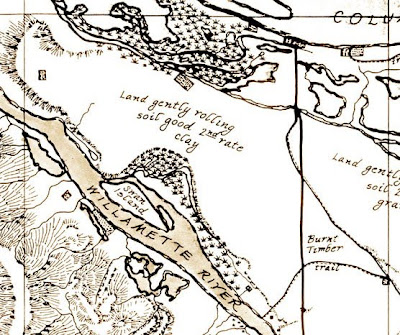Following up on the previous post, one of my all time favorite maps is the reproduction of the 1852 Survey Map offers not only development and trails, but information on soils, disappeared streams, topographic and other natural features. The map used to be available via a link to the BES website, but I can’t seem to place the source for it at the moment. The overall map covers what is considered the area of modern City of Portland (click to enlarge to a somewhat more readable scale).
A couple of details:
First, showing the area of current downtown, with natural features of Mt. Tabor and Ross Island. Note the curving depression of Sullivan’s Gulch still in full flow, replaced by what is the current routing of Interstate 84 connecting Portland from the east. There is interesting notations referring to ‘Land gently rolling, soil 2nd rate, gravelly’, denoting the floodplain of the original creek.
Second, focusing on North Portland, including Swan Island, the wetlands of Smith & Bybee Lakes (in proximity to what was used for Portland’s landfill for many years), Forest Park, and the prominent eyebrow of the overlook ridge. The references to ‘burnt timber’ and trails show the marks of early habitation. The map is a great background for some of the current hydrology and ecology of modern Portland – at least to a certain level of detail.



Hi! Just found your blog. Very fun.
Allison
Thanks Allison… are is this the PSU Allison D. that I’ve met? Just checking!